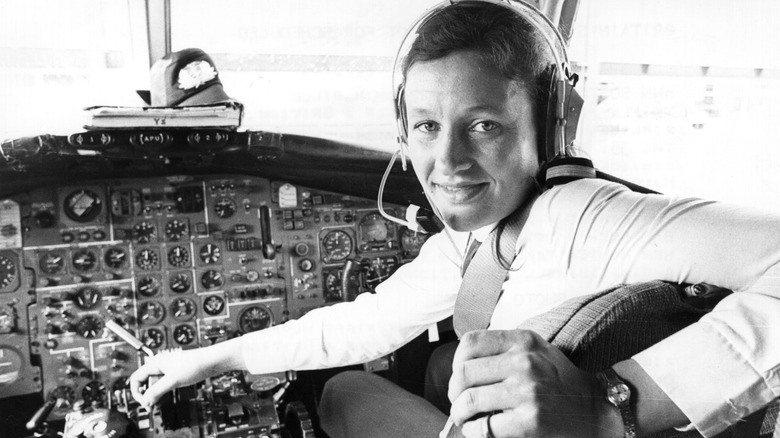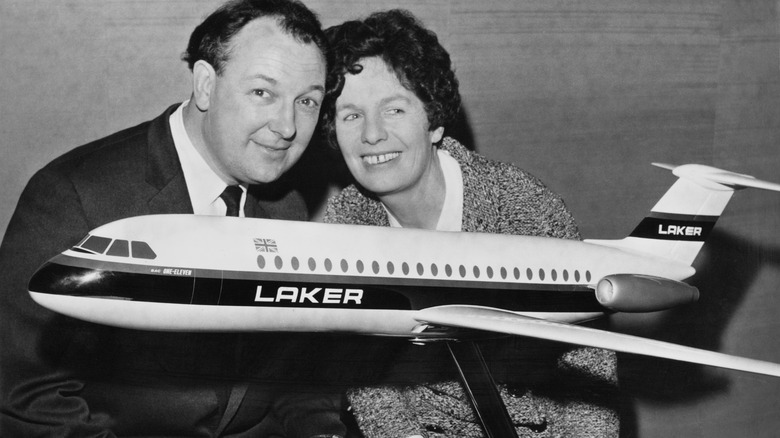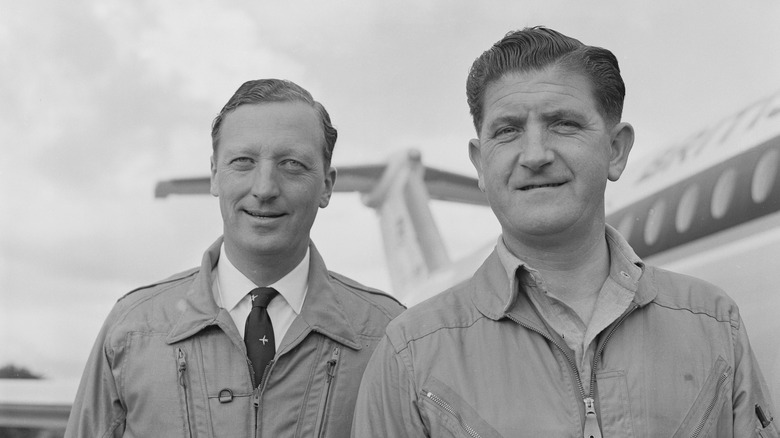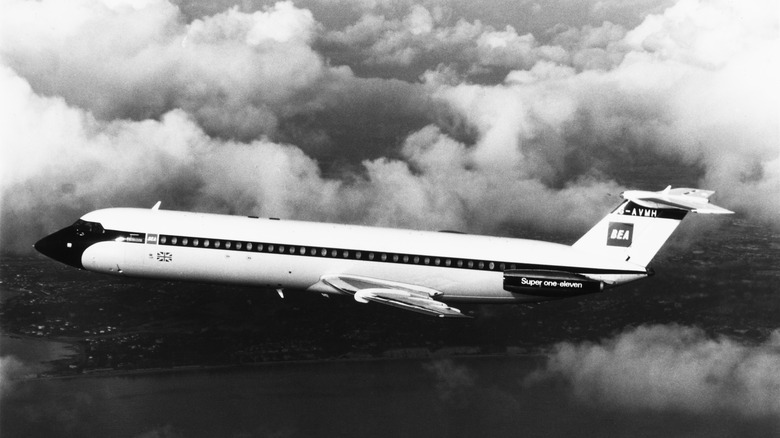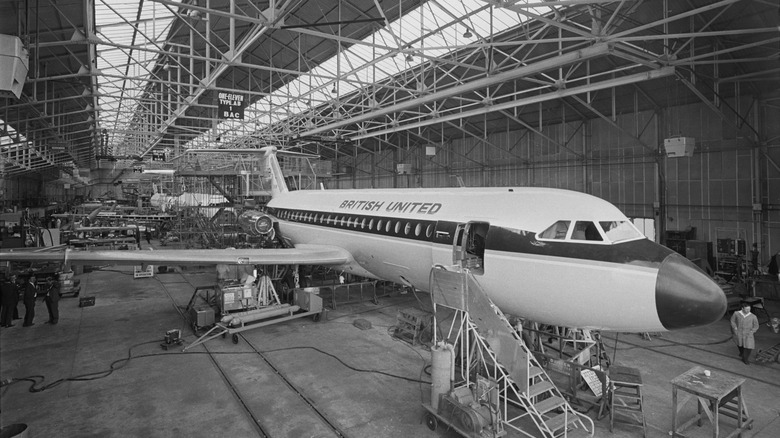Everything To Know About The Rolls-Royce Powered BAC 1-11 Jet
When the jet engine became a practical and powerful key to commercial flight, Britain played a large role in that push. De Havilland's influential DH.106 Comet, a prototype that arrived in July 1949, would become the first airliner powered by a jet engine. Just over a decade later, some of the biggest names in British aviation merged to form the British Aircraft Corporation to lessen competition among scores of entities. The group would grow to include the likes of Hunting Aircraft Limited, Vickers-Armstrongs, and English Electric Aviation.
The merger was a hard-fought process born largely of necessity. In a paper titled "The Formation of the British Aircraft Corporation (BAC) 1957-61," the Royal Aeronautical Society's Professor Keith Hayward explains that, without such a move, "there would be too many companies chasing a declining domestic market, and few had the potential to take on the American competition." Producing aircraft that could do just was a huge priority for the BAC. In the early years of the corporation's development, it produced the BAC One-Eleven which certainly left a mark on the industry.
This is the story of that jet, how it was developed, just how far and fast its Rolls-Royce engines could carry it, and its legacy in the world of jet airliners.
The conception and development of the BAC One-Eleven
Many considerations had to be made. What companies and manufacturers had to take into account was feasibility and potential profitability. Would a larger aircraft be better than a smaller one, and should the jet have a longer or shorter range? Resources were limited and certain pieces of technology were in their relative infancy, so it was a tricky proposition. The BAC One-Eleven, for its part, had its origins in a rather modest conceptual aircraft with its pieces helmed by several originating companies.
Hunting Aircraft's Hunting H107 was that first jet. The idea was a response to a request from British European Airways in the mid-1950s, seeking a new generation of aircraft supplied with a jet engine. The H107 concept was ultimately deemed too small, seating just 30 people, and never made it to the prototype stage. It remained on the drawing board into the 1960 merger and upon review showed a lot of promise in its core design. Seeking a practical approach to taking that and developing it into a larger jet without squandering resources and labor, the idea of the H107 was incorporated into that of the Vickers VC-7, a model that Vickers Armstrongs had been working on.
This combined project would result in the BAC One-Eleven, a potent statement of intent from BAC.
The first flight and original specs of the BAC One-Eleven
Though the combination of Vickers Armstrong's work on the VC-7 and Hunting Aircraft's own on the H107 surely complicated matters, BAC didn't want to waste much time getting its upcoming 1-11 into the spotlight and onto the radar of potentially interested airlines. Indeed, British United Airways was already firmly attached to the jet, ordering almost a dozen of them over two years before an early model first flew in August 1963.
The original production model, first distributed in 1965, boasted two gas turbine engines created by Rolls-Royce, the Spey 512DW. They brought considerable power, pushing the jet to a range of up to 1,865 miles and a speed of 472 mph. This gave it a greater range than its rival in the United States, the Douglas DC-9, at around 1,500 miles. As such, the BAC 1-11 attracted attention from across the Atlantic, with American Airlines having ordered 60 of them by July 1963 (quite a feat as the nation's airlines had been limited in their ability to acquire non-domestic aircraft around this time).
A competitive model in the short-haul arena from the off, the family inspired a range of new models. Let's take a closer look at the variants that followed in the original's wake.
Variants and the wider BAC One-Eleven family
The initial BAC One-Eleven was the 200 model. As is typical in the industry, subsequent variants would follow a relatively simple numbered system. Fifty-six of the 200s were produced, and the first variant to be released was the One-Eleven 300. This model featured a boosted range and enhanced engines from the Rolls-Royce family, the Spey Mk 511. Nine saw production, and though that can hardly be considered a great success, it indicated there was more to be coaxed from the base One-Eleven yet.
To capitalize on the One-Eleven's entry into United States aviation, the 400 variant followed in 1965, a model with similarly enhanced performance for that market. The mighty 500 variant followed, a longer model with space for up to 119 passengers and further upgraded Spey 512 engines. The Rombac 1-11-560 was a licensed Romanian take on the latter, while the 1-11 217 was a model adapted in limited numbers for the Royal Australian Air Force.
In all, the BAC One-Eleven was a versatile model that steadily improved and was adapted several times over its operative life. Not all of those models, though, were as prolific or successful as others.
The success and legacy of the BAC One-Eleven
The One-Eleven 300's nine completed models were operated only by British Eagle and Laker Airways. In contrast, BAC manufactured 86 of the 500 variant. This aircraft rose to prominence in a hard market at a difficult time and had the likes of the Boeing 737 to contend with.
The One-Eleven didn't have a lasting and significant impact on the wider U.S. market. After the 1977 formation of British Aerospace, the BAC group considered another new model: the BAC One-Eleven 800. This hypothetical model would be larger than the 500, holding 150 people. However, it never made it beyond a prototype.
The year 2003 saw the line cease service in Europe, and earlier application of hush kits to the Rolls-Royce engines (formidable engines indeed) proved insufficient to meet April 2002's update of laws surrounding aircraft noise. African airlines, not subject to them, would continue to operate limited numbers of One-Elevens. In 2019, Northrop Grumman stopped using its final model, a test bed, ending the One-Eleven's active history.
